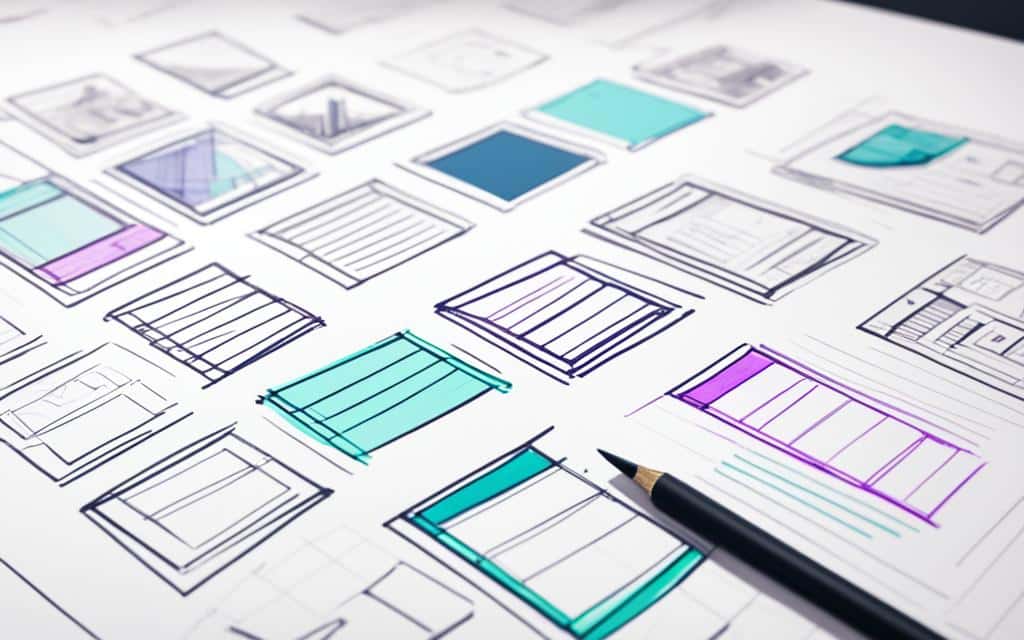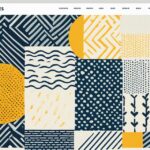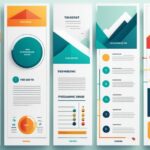Table of Contents
The web graphic design process is a crucial journey that transforms a concept into a visually stunning and functional digital vision. It is a series of steps that begins with a design brief and ends with the execution of a user-centric design.
In this article, we will explore the various stages involved in the web graphic design process, from concept to execution. We will delve into the importance of each step and provide insights on how companies can optimize this process to create efficient and effective web graphic designs.
Throughout the process, designers rely on innovative tools and techniques to bring their visions to life. They collaborate, research, brainstorm, refine, and iterate to ensure that the final design not only meets the client’s goals but also captivates and engages the target audience.
Join us on this journey as we uncover the secrets behind successful web graphic design processes. Get ready to dive into the world of concept development, design review, iteration, and user testing. Discover how companies can leverage design collaboration tools and conduct thorough research to create visually appealing and functional websites that meet the needs of their users.
If you’re passionate about creating compelling digital experiences, this article is for you. So buckle up, and let’s explore the fascinating web graphic design process together!
Setting Goals with the Design Brief
The design brief sets the stage for a successful web graphic design process. It is the first step that involves defining the goals and strategy for the design project. By establishing a well-defined design brief, designers and stakeholders can ensure a clear direction and prevent misunderstandings.
A concise design brief, no longer than two pages, communicates the vision and key criteria of the project. It acts as a guiding document that aligns everyone involved on the goals and expectations. Neglecting the design brief can result in wasted time, money, and a failure to meet project objectives.
To optimize the design brief, it is recommended to utilize design collaboration tools like Google Suite. These tools allow for easy communication and collaboration with clients or team members, facilitating the sharing of ideas, feedback, and revisions. Collaborative platforms provide a centralized space for all design brief-related discussions and ensure that all stakeholders are on the same page.
The design brief plays a crucial role in the digital design process, providing a solid foundation for the project. It sets the goals and strategy, serving as a roadmap that leads to a successful web graphic design outcome.
Benefits of a Well-Defined Design Brief:
- Clear direction for the design project
- Prevents misunderstandings and misaligned expectations
- Optimizes time, money, and resources
- Enhances communication and collaboration
- Provides a shared vision for all stakeholders
Incorporating a thorough and well-defined design brief into the web graphic design process ensures that all subsequent steps are executed with a clear purpose. It allows designers and stakeholders to work towards a common goal, resulting in efficient and effective designs.
Conducting Comprehensive Research
Research plays a vital role in the web graphic design process. It involves gathering valuable insights about the market, competitors, and target audience. By conducting thorough design research, designers can make informed decisions and ensure that the final design aligns with market trends and user expectations.
Effective design research involves several strategies to gather relevant information. Designers can start by creating key criteria to measure competitors, allowing them to analyze their strengths and weaknesses. Talking directly to customers and understanding their preferences provides valuable insights into user expectations. Reading reviews and examining competitors’ presence on social media platforms can also offer inspiration for design ideas. The knowledge gained from research helps designers shape the direction of the design, ensuring that it meets the needs of the target audience.
Thorough design research facilitates the creation of unique and impactful web graphic designs. It enables designers to understand the market landscape and identify opportunities for differentiation. By staying updated with current market trends and user preferences, designers can develop designs that resonate with the intended audience.
Brainstorming and Concept Development
Brainstorming and concept development are crucial stages in the web graphic design process. During brainstorming, designers generate a multitude of ideas for the design, considering factors such as inspiration, colours, emotions, mood, and images. Collaboration with colleagues or clients can lead to truly amazing designs.
“Creativity is contagious. Pass it on.” – Albert Einstein
However, organizing live brainstorming sessions can be challenging in remote or busy environments. That’s where graphic design project management software comes in handy. Tools like Google Docs, Canva, and Miro enable asynchronous yet effective brainstorming, facilitating collaboration and idea sharing.
The concepts developed during this stage serve as the foundation for the final design. It is crucial to explore a wide range of options and consider feedback from stakeholders to ensure a successful outcome.
The Power of Collaboration
The collaborative nature of brainstorming allows for a diverse range of perspectives and ideas. By involving colleagues or clients, designers can tap into different expertise and experiences, leading to more innovative and comprehensive designs.
Collaboration fosters an environment of trust and creativity, where ideas can be freely exchanged and built upon. It encourages thinking beyond individual perspectives and opens up new possibilities.
Optimizing Brainstorming with Graphic Design Project Management Software
Graphic design project management software plays a vital role in facilitating effective brainstorming and concept development. These tools provide a platform for visualizing ideas, collecting feedback, and collaborating with team members.
Using Google Docs, designers can create shared documents where ideas, sketches, and inspirations can be easily shared and discussed. Canva offers a comprehensive design platform with templates, design assets, and collaboration features. Miro allows for real-time collaborative brainstorming through virtual whiteboards and sticky note exercises.
With graphic design project management software, designers can compare and contrast different concepts, iterate on ideas, and involve stakeholders in the decision-making process. These tools streamline collaboration, making it easier to manage projects and ensure that the final design meets the expectations and requirements of all involved parties.
Polishing and Refining the Design
The design development stage is where the initial concepts are polished and refined. Designers have the opportunity to experiment with colours, layouts, and styles to create something beautiful and functional. It is recommended to try different variations and keep all mockups, as ideas that may not work initially could be useful later in the process. Taking the time to sleep on the ideas and gathering feedback from others can also lead to improvements. Designers can become like mad professors, exploring different possibilities until they are satisfied with the final result. This stage requires attention to detail and a focus on creating a visually appealing and user-friendly design.
Create Mockups to Visualize Ideas
During the design development stage, designers create mockups to visualize their ideas. Mockups serve as a visual representation of the design, allowing designers and stakeholders to see how different elements come together. By creating mockups, designers can get a better sense of how the design will look and feel, and make necessary refinements before proceeding to the next stage.
Experiment with Colors, Layouts, and Styles
The design development stage is a time for designers to experiment with different colors, layouts, and styles. They can explore various color palettes that evoke the desired mood and emotions. Trying out different layouts helps determine the most effective way to present information and guide users through the website. Additionally, designers can experiment with different styles to find the one that aligns with the brand’s aesthetic and target audience.
Get Feedback from Others
Gathering feedback from others is crucial during the design development stage. Designers can share their mockups with colleagues, clients, or focus groups to gather different perspectives and insights. Feedback from others can help identify areas for improvement and provide fresh ideas or suggestions that may enhance the design. By seeking feedback, designers can refine their work and ensure it meets the needs and expectations of the intended users.
Refine the Design with Attention to Detail
Refining the design requires meticulous attention to detail. Designers should focus on fine-tuning every aspect of the design, ensuring consistency, clarity, and functionality. This includes refining typography, optimizing images, and ensuring that all interactive elements function as intended. By paying close attention to these details, designers can elevate the overall user experience and create a design that meets the highest standards.
Getting Feedback with Design Review
Design review is a critical step in the web graphic design process. It involves presenting the design ideas to stakeholders and collecting structured and meaningful feedback. By gathering insights from various perspectives, designers can refine their work and ensure that it meets the desired goals and expectations. Effective design review requires a comprehensive approach that incorporates input from both professionals and end-users.
The Importance of Structured Feedback
Structured feedback is essential for a productive design review. It provides clear and actionable insights that designers can use to improve their work. Instead of generic comments, structured feedback focuses on specific aspects of the design, such as visual elements, user experience, and functionality. This enables designers to address specific issues and make informed decisions to enhance the overall design.
“Structured feedback allows for a more efficient design iteration process. It helps designers pinpoint areas that require improvement and take appropriate actions to refine the design.”
Using Design Approval Software
Implementing design approval software can significantly streamline the design review process. These tools provide a centralized platform where designers and stakeholders can collaborate, share feedback, and track changes. Design approval software offers features such as annotations, attachments, highlights, and strikeouts, making it easier for reviewers to provide specific and actionable feedback.
Additionally, design approval software helps organize feedback, ensuring that all comments are properly documented and addressed. This streamlines the iteration process and minimizes the risk of overlooking important feedback. Designers can easily refer to previous feedback and track the progress of design refinements.
Table: Benefits of Design Approval Software
| Benefits | Description |
|---|---|
| Centralized Collaboration | Provides a platform for seamless collaboration and feedback exchange. |
| Streamlined Feedback | Enables structured feedback through annotation tools and version control. |
| Efficient Iteration | Simplifies the design refinement process, ensuring that feedback is implemented. |
| Improved Communication | Facilitates clear communication among designers, stakeholders, and clients. |
Implementing design approval software revolutionizes the design review process, enabling designers to create high-quality and user-centric designs more efficiently and effectively.
Iterating and Improving the Design
Iteration is an essential part of the web graphic design process. It involves incorporating feedback, making improvements, and collecting further feedback until the design meets the desired requirements. Design iteration allows designers to refine their work and create designs that are truly outstanding.
However, waiting for everyone to review the design and keeping track of multiple versions can be slow and frustrating. Design review tools have greatly improved the iteration process by providing a streamlined and efficient way to gather feedback and make improvements.
One such tool is Filestage, a leading design review platform that simplifies the collaboration process. With Filestage, designers can easily share their designs with stakeholders and receive structured and meaningful feedback. The platform allows for side-by-side comparisons, highlighting the latest version, and revisiting previous versions and feedback.
By making it easier for reviewers to provide feedback, designers can streamline the iteration stage and create a more effective and enjoyable process for everyone involved. This not only saves time but also leads to better design outcomes.
Design version control is another crucial aspect of design iteration. It ensures that designers can keep track of different versions of their work and easily revert back to previous iterations if needed. Tools like Filestage provide robust version control capabilities, allowing designers to maintain a clear and organized workflow.
With design review tools and version control, designers can iterate on their designs with confidence, knowing that they have a structured and efficient process in place. These tools enable collaboration, improve communication, and ultimately lead to higher-quality design outcomes.
Overall, design iteration, supported by design review tools and version control, is a key element in creating exceptional web graphic designs. It allows designers to incorporate feedback, make improvements, and refine their work until it meets the desired criteria. By utilizing these tools, designers can streamline the iteration process and create visually stunning and user-friendly designs.
Conclusion
The web graphic design process is a meticulous and collaborative journey that plays a critical role in creating efficient and user-centric designs. Each step, from setting goals with the design brief to user testing, contributes to the overall success of the final design. Through thorough research, designers can gather valuable insights and inspiration to create innovative ideas. Brainstorming and concept development serve as the foundation for the design, allowing for the exploration of various possibilities.
Design review and iteration are essential stages that involve receiving feedback and making improvements to refine the design. By leveraging design collaboration tools, such as Filestage, designers can streamline the review process and gather structured and meaningful feedback. These tools enable clear communication and collaboration, resulting in an efficient design workflow.
Ultimately, the web graphic design process is vital for companies looking to effectively communicate, engage with their audience, and create visually appealing and functional websites. By following a systematic approach and leveraging design collaboration tools, companies can optimize their design workflow and bring their digital visions to life. It is essential for designers to prioritize user-centric designs that meet the needs and preferences of their target audience.
FAQ
What is the web graphic design process?
The web graphic design process involves several steps that take a concept and bring it to life through execution. It is the process of creating visually appealing and functional websites.
What is the first step in the web graphic design process?
The first step in the web graphic design process is setting goals with the design brief. A well-defined design brief provides a clear direction for the project and ensures everyone is aligned on the goals and expectations.
Why is research important in the web graphic design process?
Research is crucial in the web graphic design process as it helps designers gather information about the market, competitors, and target audience. It provides valuable insights and inspiration, ensuring that the final design aligns with market trends and user expectations.
How can brainstorming and concept development enhance the design process?
Brainstorming and concept development allow designers to generate a multitude of ideas and refine them. Collaborating with colleagues or clients during this stage can lead to truly amazing designs. Graphic design project management software facilitates asynchronous brainstorming and collaboration, even in remote or busy environments.
How can designers polish and refine their designs?
Designers can polish and refine their designs by trying different variations, experimenting with colors, layouts, and styles, and gathering feedback from others. Keeping all mockups and taking the time to sleep on ideas can also lead to improvements in the design.
Why is design review important in the graphic design process?
Design review allows designers to present their ideas to stakeholders and collect structured and meaningful feedback. It helps ensure the design meets the desired requirements and provides an opportunity for collaboration and improvement.
How can designers iterate and improve their designs?
Designers can iterate and improve their designs by incorporating feedback, making improvements, and collecting further feedback until the design meets the desired requirements. Design review tools that offer version control and side-by-side comparisons can streamline the iteration process.
What are the benefits of following the web graphic design process?
Following the web graphic design process allows companies to create efficient and user-centric designs. It ensures that goals are clearly communicated, research informs the design, ideas are refined through feedback, and the design goes through iterations to meet desired requirements.













